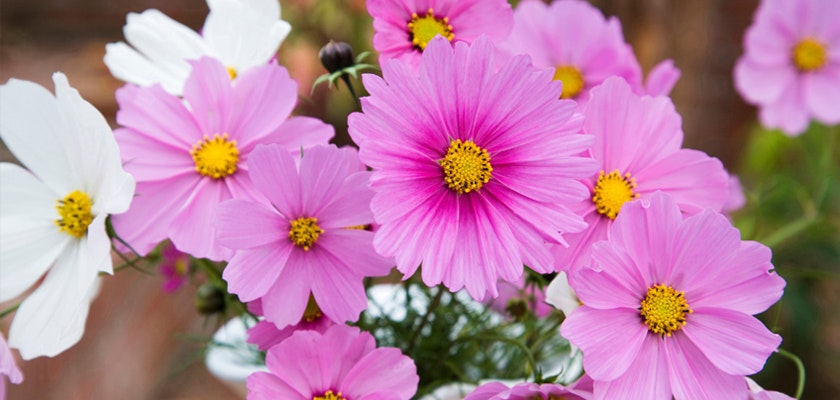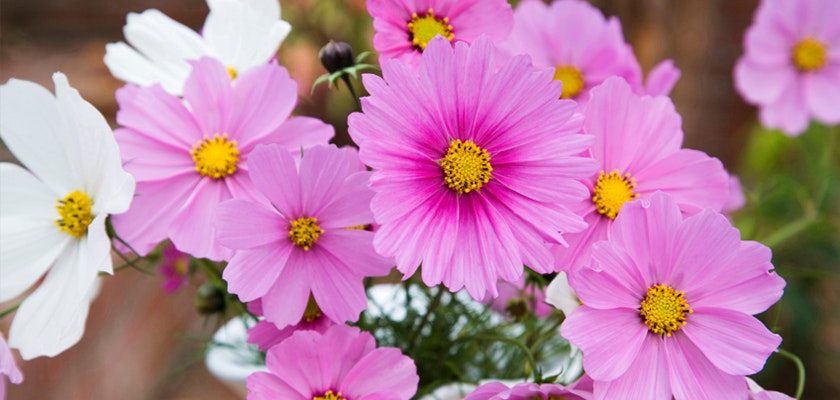October Birth Flowers: Exploring the Marigold and Cosmos
October is a month brimming with the golden hues of autumn, and it's fitting that its birth flowers, the marigold and cosmos, mirror this seasonal splendor.
Explore the history, symbolism, and care tips for October marigold and cosmos, with BloomsyBox
Marigold and cosmos not only add color and warmth to gardens but also carry rich histories and deep symbolic meanings. Whether celebrating a birthday or simply enjoying the beauty of these blooms, understanding their stories and care tips enhances our appreciation for these remarkable flowers.
Explore the history, symbolism, and care tips for October marigold and cosmos, with BloomsyBox
Marigold and cosmos not only add color and warmth to gardens but also carry rich histories and deep symbolic meanings. Whether celebrating a birthday or simply enjoying the beauty of these blooms, understanding their stories and care tips enhances our appreciation for these remarkable flowers.
The marigold, with its fiery colors, is often seen as a symbol of warmth and passion. Its brightly hued petals are reminiscent of the sun, making it a perfect flower to highlight the transition from summer to fall. The marigold's association with the sun isn't just visual; it has historical roots in various cultures where it was revered as a sacred flower.
The cosmos, on the other hand, offers a delicate contrast with its airy, daisy-like appearance. Known for its serene beauty, the cosmos symbolizes harmony and tranquility. Its name, derived from the Greek word for "ordered universe," reflects its graceful presence and the sense of calm it brings to any garden.
Both flowers are celebrated for their aesthetic appeal and their ability to thrive in different conditions. Marigolds are hardy and easy to grow, making them a favorite among gardeners. Their bright colors can light up any garden space, and they have practical uses as well. Similarly, cosmos are beloved for their graceful blooms and ease of care. They attract pollinators, adding life and movement to gardens.
At BloomsyBox, we curate floral arrangements that capture the essence of these October birth flowers. Our carefully crafted bouquets featuring marigolds and cosmos are perfect for celebrating October birthdays or simply bringing a touch of autumnal beauty into your home. In the following sections, we'll delve deeper into the history, significance, and care tips for marigolds and cosmos, along with some interesting facts that make these flowers truly special.
Marigold
Marigolds are a staple in gardens worldwide, known for their bright, cheerful blooms and distinctive scent. They belong to the Asteraceae family and are native to the Americas, particularly Central and South America. These flowers come in various shades of yellow, orange, and red, adding a burst of color to any garden.
One of the reasons marigolds are so popular is their versatility. They can be grown in garden beds, borders, pots, or even as companion plants in vegetable gardens. Their robust nature and vibrant colors make them a favorite among gardeners looking to add a touch of brightness to their landscapes.
Beyond their beauty, marigolds have practical benefits as well. They are known to repel pests like aphids and nematodes, making them excellent companion plants. Additionally, marigold flowers and extracts are used in cosmetics and traditional medicine, highlighting their multifaceted value.
History and Significance
The history of marigolds dates back to ancient civilizations. In Aztec culture, marigolds were considered sacred and were used in religious ceremonies and medicinal practices. The Aztecs believed that marigolds had protective properties and could ward off evil spirits. They were also used to treat various ailments, from digestive issues to skin infections.
Marigolds were introduced to Europe during the Spanish conquest of the Americas. They quickly gained popularity and spread across the continent, admired for their striking appearance and ease of cultivation. By the 16th century, marigolds had made their way to India, where they became deeply embedded in cultural and religious practices.
In India, marigolds are widely used in festivals, weddings, and religious ceremonies. They are considered symbols of purity, love, and good fortune. Garlands of marigolds are often used to adorn deities, homes, and event spaces, signifying respect and celebration.
The symbolism of marigolds varies across cultures. In Mexico, marigolds play a significant role in Día de los Muertos (Day of the Dead) celebrations. They are known as "cempasúchil" and are believed to guide the spirits of deceased loved ones back to the realm of the living. The vibrant petals are used to create intricate altars and pathways, honoring and remembering those who have passed away.
Marigolds are also associated with the sun and its life-giving energy. Their bright, sunny colors are thought to represent warmth, positivity, and joy. In the language of flowers, marigolds symbolize love, passion, and creativity. They are often given as gifts to express affection and admiration.
Caring for Marigolds
To ensure your marigolds thrive and display their full beauty, follow these essential care tips:
1. Watering: Marigolds prefer moderately moist soil. Water them regularly, especially during dry spells, ensuring the soil remains evenly moist but not waterlogged.
2. Sun Exposure: Plant marigolds in full sunlight for at least six hours a day. Adequate sunlight promotes healthy growth and vibrant blooms.
3. Soil Needs: Marigolds thrive in well-drained soil. If planting in heavy clay soil, amend it with compost or sand to improve drainage.
4. Mulching: Apply a layer of mulch around the base of the plants to retain moisture, regulate soil temperature, and suppress weeds.
5. Fertilization: Use a balanced, all-purpose fertilizer every 4 to 6 weeks during the growing season. Over-fertilizing can lead to excessive foliage growth at the expense of flowers.
6. Deadheading: Regularly remove spent blooms to encourage continuous flowering. This practice extends the blooming period and keeps the plants looking tidy.
7. Pest Control: Marigolds are generally resistant to pests, but they can occasionally be affected by aphids and spider mites. Inspect plants regularly and treat infestations promptly with insecticidal soap or neem oil.
8. Disease Management: Ensure proper air circulation around plants to reduce the risk of fungal diseases like powdery mildew. Avoid overhead watering to prevent moisture from settling on the foliage.
9. Winter Care: In colder climates, marigolds are typically grown as annuals. Collect seeds from mature pods at the end of the growing season for planting next year. In warmer regions, they may reseed themselves and return the following spring.
10. Companion Planting: Consider planting marigolds alongside vegetables and other garden plants. Their natural pest-repellent properties can benefit the entire garden ecosystem.
Interesting Facts About Marigolds
1. Historical Uses: Marigolds have been used in traditional medicine for centuries. The Aztecs utilized marigold extracts to treat various ailments, including skin infections and digestive issues. The flower's anti-inflammatory and antiseptic properties are still recognized today.
2. Edible Petals: Marigold petals are edible and can be used to add color and flavor to salads, soups, and other dishes. They are sometimes referred to as "poor man's saffron" due to their similar taste and color.
3. Cosmetic Applications: Marigold extracts are commonly used in skincare products for their soothing and healing properties. They are known to reduce inflammation, promote wound healing, and improve skin health.
4. Symbolism in Art: Marigolds have been depicted in various forms of art throughout history, symbolizing different themes such as love, passion, and remembrance. Their vibrant colors make them a popular subject for paintings and illustrations.
5. Diverse Varieties: There are over 50 species of marigolds, each with unique characteristics and growth habits. Some popular varieties include the French marigold (Tagetes patula), African marigold (Tagetes erecta), and signet marigold (Tagetes tenuifolia).
The marigold, with its fiery colors, is often seen as a symbol of warmth and passion. Its brightly hued petals are reminiscent of the sun, making it a perfect flower to highlight the transition from summer to fall. The marigold's association with the sun isn't just visual; it has historical roots in various cultures where it was revered as a sacred flower.
The cosmos, on the other hand, offers a delicate contrast with its airy, daisy-like appearance. Known for its serene beauty, the cosmos symbolizes harmony and tranquility. Its name, derived from the Greek word for "ordered universe," reflects its graceful presence and the sense of calm it brings to any garden.
Both flowers are celebrated for their aesthetic appeal and their ability to thrive in different conditions. Marigolds are hardy and easy to grow, making them a favorite among gardeners. Their bright colors can light up any garden space, and they have practical uses as well. Similarly, cosmos are beloved for their graceful blooms and ease of care. They attract pollinators, adding life and movement to gardens.
At BloomsyBox, we curate floral arrangements that capture the essence of these October birth flowers. Our carefully crafted bouquets featuring marigolds and cosmos are perfect for celebrating October birthdays or simply bringing a touch of autumnal beauty into your home. In the following sections, we'll delve deeper into the history, significance, and care tips for marigolds and cosmos, along with some interesting facts that make these flowers truly special.
Marigold
Marigolds are a staple in gardens worldwide, known for their bright, cheerful blooms and distinctive scent. They belong to the Asteraceae family and are native to the Americas, particularly Central and South America. These flowers come in various shades of yellow, orange, and red, adding a burst of color to any garden.
One of the reasons marigolds are so popular is their versatility. They can be grown in garden beds, borders, pots, or even as companion plants in vegetable gardens. Their robust nature and vibrant colors make them a favorite among gardeners looking to add a touch of brightness to their landscapes.
Beyond their beauty, marigolds have practical benefits as well. They are known to repel pests like aphids and nematodes, making them excellent companion plants. Additionally, marigold flowers and extracts are used in cosmetics and traditional medicine, highlighting their multifaceted value.
History and Significance
The history of marigolds dates back to ancient civilizations. In Aztec culture, marigolds were considered sacred and were used in religious ceremonies and medicinal practices. The Aztecs believed that marigolds had protective properties and could ward off evil spirits. They were also used to treat various ailments, from digestive issues to skin infections.
Marigolds were introduced to Europe during the Spanish conquest of the Americas. They quickly gained popularity and spread across the continent, admired for their striking appearance and ease of cultivation. By the 16th century, marigolds had made their way to India, where they became deeply embedded in cultural and religious practices.
In India, marigolds are widely used in festivals, weddings, and religious ceremonies. They are considered symbols of purity, love, and good fortune. Garlands of marigolds are often used to adorn deities, homes, and event spaces, signifying respect and celebration.
The symbolism of marigolds varies across cultures. In Mexico, marigolds play a significant role in Día de los Muertos (Day of the Dead) celebrations. They are known as "cempasúchil" and are believed to guide the spirits of deceased loved ones back to the realm of the living. The vibrant petals are used to create intricate altars and pathways, honoring and remembering those who have passed away.
Marigolds are also associated with the sun and its life-giving energy. Their bright, sunny colors are thought to represent warmth, positivity, and joy. In the language of flowers, marigolds symbolize love, passion, and creativity. They are often given as gifts to express affection and admiration.
Caring for Marigolds
To ensure your marigolds thrive and display their full beauty, follow these essential care tips:
1. Watering: Marigolds prefer moderately moist soil. Water them regularly, especially during dry spells, ensuring the soil remains evenly moist but not waterlogged.
2. Sun Exposure: Plant marigolds in full sunlight for at least six hours a day. Adequate sunlight promotes healthy growth and vibrant blooms.
3. Soil Needs: Marigolds thrive in well-drained soil. If planting in heavy clay soil, amend it with compost or sand to improve drainage.
4. Mulching: Apply a layer of mulch around the base of the plants to retain moisture, regulate soil temperature, and suppress weeds.
5. Fertilization: Use a balanced, all-purpose fertilizer every 4 to 6 weeks during the growing season. Over-fertilizing can lead to excessive foliage growth at the expense of flowers.
6. Deadheading: Regularly remove spent blooms to encourage continuous flowering. This practice extends the blooming period and keeps the plants looking tidy.
7. Pest Control: Marigolds are generally resistant to pests, but they can occasionally be affected by aphids and spider mites. Inspect plants regularly and treat infestations promptly with insecticidal soap or neem oil.
8. Disease Management: Ensure proper air circulation around plants to reduce the risk of fungal diseases like powdery mildew. Avoid overhead watering to prevent moisture from settling on the foliage.
9. Winter Care: In colder climates, marigolds are typically grown as annuals. Collect seeds from mature pods at the end of the growing season for planting next year. In warmer regions, they may reseed themselves and return the following spring.
10. Companion Planting: Consider planting marigolds alongside vegetables and other garden plants. Their natural pest-repellent properties can benefit the entire garden ecosystem.
Interesting Facts About Marigolds
1. Historical Uses: Marigolds have been used in traditional medicine for centuries. The Aztecs utilized marigold extracts to treat various ailments, including skin infections and digestive issues. The flower's anti-inflammatory and antiseptic properties are still recognized today.
2. Edible Petals: Marigold petals are edible and can be used to add color and flavor to salads, soups, and other dishes. They are sometimes referred to as "poor man's saffron" due to their similar taste and color.
3. Cosmetic Applications: Marigold extracts are commonly used in skincare products for their soothing and healing properties. They are known to reduce inflammation, promote wound healing, and improve skin health.
4. Symbolism in Art: Marigolds have been depicted in various forms of art throughout history, symbolizing different themes such as love, passion, and remembrance. Their vibrant colors make them a popular subject for paintings and illustrations.
5. Diverse Varieties: There are over 50 species of marigolds, each with unique characteristics and growth habits. Some popular varieties include the French marigold (Tagetes patula), African marigold (Tagetes erecta), and signet marigold (Tagetes tenuifolia).
Cosmos
Cosmos are delicate, daisy-like flowers that bring an air of elegance and serenity to gardens. Originating from Mexico, these flowers belong to the Asteraceae family and are known for their feathery foliage and slender stems. Cosmos come in a variety of colors, including pink, white, magenta, and purple, adding a touch of grace to any landscape.
One of the standout features of cosmos is their ability to attract pollinators. Bees, butterflies, and other beneficial insects are drawn to their nectar-rich blooms, making cosmos a valuable addition to pollinator gardens. Their long-lasting flowers and ease of care make them a favorite among gardeners.
Cosmos are also appreciated for their versatility. They can be grown in garden beds, borders, or containers, and they thrive in both formal and informal garden settings. Their tall, airy stems add height and movement to gardens, creating a visually appealing contrast with other plants.
History and Significance
The name "cosmos" is derived from the Greek word "kosmos," which means "harmony" or "ordered universe." This name reflects the flower's balanced and symmetrical beauty. Cosmos were first cultivated in Mexico, where they were prized for their ornamental value and vibrant colors.
Cosmos were introduced to Europe in the 18th century and quickly gained popularity for their ease of cultivation and striking appearance. They became a staple in cottage gardens and were often used in floral arrangements for their delicate, daisy-like blooms.
In the language of flowers, cosmos symbolize harmony, balance, and tranquility. Their serene appearance and graceful form evoke a sense of peace and calmness. Giving cosmos to someone conveys a message of modesty and a sincere declaration of love.
Cosmos also hold cultural significance in various societies. In Mexico, they are associated with the Day of the Dead celebrations, where they are used to honor and remember deceased loved ones. The flower's bright colors and long-lasting blooms make it a fitting tribute during these festivities.
Throughout history, cosmos have been associated with love and beauty. In Victorian floriography cosmos were used to convey romantic sentiments and admiration. Their delicate petals and vibrant hues made them a popular choice for bouquets and garden displays, symbolizing the purity and simplicity of true love.
Caring for Cosmos
To keep your cosmos healthy and thriving, follow these comprehensive care tips:
1. Watering: Cosmos are drought-tolerant once established but prefer moderately moist soil. Water them deeply once a week, more frequently during dry spells, ensuring the soil remains moist but not waterlogged.
2. Sun Exposure: Plant cosmos in full sunlight for at least six to eight hours a day. They thrive in sunny spots, which promote robust growth and abundant blooming.
3. Soil Needs: Cosmos are adaptable to various soil types but perform best in well-drained soil. They tolerate poor soils and do not require heavy fertilization, making them easy to grow in less-than-ideal conditions.
4. Mulching: Apply a layer of mulch around the base of the plants to retain moisture, regulate soil temperature, and suppress weeds. Mulching also helps prevent soil erosion and maintain soil health.
5. Fertilization: Cosmos do not need much fertilizer. Over-fertilizing can result in lush foliage with fewer flowers. A light application of balanced, all-purpose fertilizer once or twice during the growing season is sufficient.
6. Deadheading: Regularly remove spent blooms to encourage continuous flowering. Deadheading keeps the plants looking tidy and extends the blooming period until the first frost.
7. Pruning: Pruning is not typically necessary for cosmos, but you can pinch back young plants to encourage bushier growth. This practice helps maintain a more compact and manageable shape.
8. Pest Control: Cosmos have few pest problems but can occasionally attract aphids and spider mites. Inspect plants regularly and treat infestations with insecticidal soap or neem oil if needed. Healthy plants are more resistant to pests.
9. Disease Management: Cosmos are generally disease-resistant but can be susceptible to fungal issues if grown in overly wet conditions. Ensure proper spacing between plants for good air circulation and avoid overhead watering.
10. Winter Care: In colder climates, cosmos are grown as annuals. They will not survive frost and should be replanted each year. Collect seeds from mature pods at the end of the growing season for planting next year. In warmer regions, cosmos may reseed themselves and return the following spring.
Interesting Facts About Cosmos
1. Pollinator Attraction: Cosmos are excellent for attracting pollinators such as bees, butterflies, and hummingbirds. Their nectar-rich blooms provide a valuable food source, supporting local ecosystems and biodiversity.
2. Edible Flowers: While not commonly consumed, cosmos petals are edible and can be used to add color and a mild, slightly sweet flavor to salads and desserts. They make an attractive garnish for culinary creations.
3. Historical Significance: Cosmos were first cultivated by Spanish priests in Mexican mission gardens. They admired the flower's orderly arrangement of petals, which inspired the name "cosmos," reflecting the harmonious nature of the universe.
4. Traditional Medicine: Certain species of cosmos have been used in traditional medicine. For example, Cosmos caudatus, known as "Ulam Raja" in Malaysia, is used as a natural remedy for its antioxidant properties and potential health benefits.
5. Variety and Hybridization: There are numerous species and cultivars of cosmos, each offering unique colors and forms. Popular species include Cosmos bipinnatus, known for its large, colorful flowers, and Cosmos sulphureus, which features bright orange and yellow blooms.
Cosmos
Cosmos are delicate, daisy-like flowers that bring an air of elegance and serenity to gardens. Originating from Mexico, these flowers belong to the Asteraceae family and are known for their feathery foliage and slender stems. Cosmos come in a variety of colors, including pink, white, magenta, and purple, adding a touch of grace to any landscape.
One of the standout features of cosmos is their ability to attract pollinators. Bees, butterflies, and other beneficial insects are drawn to their nectar-rich blooms, making cosmos a valuable addition to pollinator gardens. Their long-lasting flowers and ease of care make them a favorite among gardeners.
Cosmos are also appreciated for their versatility. They can be grown in garden beds, borders, or containers, and they thrive in both formal and informal garden settings. Their tall, airy stems add height and movement to gardens, creating a visually appealing contrast with other plants.
History and Significance
The name "cosmos" is derived from the Greek word "kosmos," which means "harmony" or "ordered universe." This name reflects the flower's balanced and symmetrical beauty. Cosmos were first cultivated in Mexico, where they were prized for their ornamental value and vibrant colors.
Cosmos were introduced to Europe in the 18th century and quickly gained popularity for their ease of cultivation and striking appearance. They became a staple in cottage gardens and were often used in floral arrangements for their delicate, daisy-like blooms.
In the language of flowers, cosmos symbolize harmony, balance, and tranquility. Their serene appearance and graceful form evoke a sense of peace and calmness. Giving cosmos to someone conveys a message of modesty and a sincere declaration of love.
Cosmos also hold cultural significance in various societies. In Mexico, they are associated with the Day of the Dead celebrations, where they are used to honor and remember deceased loved ones. The flower's bright colors and long-lasting blooms make it a fitting tribute during these festivities.
Throughout history, cosmos have been associated with love and beauty. In Victorian floriography cosmos were used to convey romantic sentiments and admiration. Their delicate petals and vibrant hues made them a popular choice for bouquets and garden displays, symbolizing the purity and simplicity of true love.
Caring for Cosmos
To keep your cosmos healthy and thriving, follow these comprehensive care tips:
1. Watering: Cosmos are drought-tolerant once established but prefer moderately moist soil. Water them deeply once a week, more frequently during dry spells, ensuring the soil remains moist but not waterlogged.
2. Sun Exposure: Plant cosmos in full sunlight for at least six to eight hours a day. They thrive in sunny spots, which promote robust growth and abundant blooming.
3. Soil Needs: Cosmos are adaptable to various soil types but perform best in well-drained soil. They tolerate poor soils and do not require heavy fertilization, making them easy to grow in less-than-ideal conditions.
4. Mulching: Apply a layer of mulch around the base of the plants to retain moisture, regulate soil temperature, and suppress weeds. Mulching also helps prevent soil erosion and maintain soil health.
5. Fertilization: Cosmos do not need much fertilizer. Over-fertilizing can result in lush foliage with fewer flowers. A light application of balanced, all-purpose fertilizer once or twice during the growing season is sufficient.
6. Deadheading: Regularly remove spent blooms to encourage continuous flowering. Deadheading keeps the plants looking tidy and extends the blooming period until the first frost.
7. Pruning: Pruning is not typically necessary for cosmos, but you can pinch back young plants to encourage bushier growth. This practice helps maintain a more compact and manageable shape.
8. Pest Control: Cosmos have few pest problems but can occasionally attract aphids and spider mites. Inspect plants regularly and treat infestations with insecticidal soap or neem oil if needed. Healthy plants are more resistant to pests.
9. Disease Management: Cosmos are generally disease-resistant but can be susceptible to fungal issues if grown in overly wet conditions. Ensure proper spacing between plants for good air circulation and avoid overhead watering.
10. Winter Care: In colder climates, cosmos are grown as annuals. They will not survive frost and should be replanted each year. Collect seeds from mature pods at the end of the growing season for planting next year. In warmer regions, cosmos may reseed themselves and return the following spring.
Interesting Facts About Cosmos
1. Pollinator Attraction: Cosmos are excellent for attracting pollinators such as bees, butterflies, and hummingbirds. Their nectar-rich blooms provide a valuable food source, supporting local ecosystems and biodiversity.
2. Edible Flowers: While not commonly consumed, cosmos petals are edible and can be used to add color and a mild, slightly sweet flavor to salads and desserts. They make an attractive garnish for culinary creations.
3. Historical Significance: Cosmos were first cultivated by Spanish priests in Mexican mission gardens. They admired the flower's orderly arrangement of petals, which inspired the name "cosmos," reflecting the harmonious nature of the universe.
4. Traditional Medicine: Certain species of cosmos have been used in traditional medicine. For example, Cosmos caudatus, known as "Ulam Raja" in Malaysia, is used as a natural remedy for its antioxidant properties and potential health benefits.
5. Variety and Hybridization: There are numerous species and cultivars of cosmos, each offering unique colors and forms. Popular species include Cosmos bipinnatus, known for its large, colorful flowers, and Cosmos sulphureus, which features bright orange and yellow blooms.
By understanding the rich history, significance, and care requirements of marigolds and cosmos, you can appreciate these October birth flowers even more. At BloomsyBox, we celebrate their unique qualities and offer real flower delivery that honor their beauty and meaning. Whether you're marking a special occasion or simply enjoying their splendor, marigolds and cosmos are sure to leave a lasting impression.
By understanding the rich history, significance, and care requirements of marigolds and cosmos, you can appreciate these October birth flowers even more. At BloomsyBox, we celebrate their unique qualities and offer real flower delivery that honor their beauty and meaning. Whether you're marking a special occasion or simply enjoying their splendor, marigolds and cosmos are sure to leave a lasting impression.




